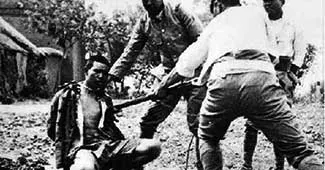The Case of the Makapili in Tanauan and the Heroic Dr. Brigido Carandang
From the archives of the Supreme Court of the Philippines, we get this story1 of both the heroism and treachery of fellow Batangueños on opposite sides of the political divide back during the Japanese occupation of the Philippines.
On the one hand, there was one Leandro Dimapilis, originally charged with four counts of treason before the Batangas Court of First Instance, three of which were dismissed. He was, however, found guilty on one of the charges and sentence to pay a fine of ₱5,000 and serve a 15-year jail term.
It was this verdict that he appealed all the way up to the Supreme Court.
On the other hand, there was Dr. Brigido Carandang, a citizen of Tanauan and just one of the many unsung heroes among the Batangueños who resisted the Japanese occupation in whatever way possible and rallied behind the underground resistance movement.
One day in December of 1944, Dimapilis with a group of Makapilis and Japanese soldiers went to the public market of the then-town of Tanauan to visit the store of the former Amelia Laurel, wife of Carandang. The Makapilis were members of the Makabayang Katipunan ng mga Pilipino (Patriotic Association Filipinos2), a pro-Japanese group in World War II.
At this time, the Americans had already landed in Leyte and were starting to build up bases in Mindoro in preparation for the invasion of Luzon3. This invasion would include a landing in Nasugbu in January of 1945. By December of the previous year, understandably the Japanese had started to get fidgety.
That December day at the public market in Tanauan, Dimapilis and company’s singular purpose was the arrest of Carandang. According to the testimonies of Moises Carandang and Porfirio Laurel, presumably related to the doctor and his wife and present at the market that day, Dimapilis and one Domingo Narvaez upon arrival at the Amelia’s market stall immediately pointed out Carandang to the Japanese as the “physician and supplier of the guerillas.”
Thereupon, the Japanese soldiers grabbed Carandang and took him to their garrison, with Dimapilis “following at some distance behind.” The witnesses must have followed the arresting party to the Japanese garrison because it was from their description that we are able to know what happened next:
“…after a while, Dr. Carandang was brought down and his face was swollen and disfigured beyond recognition, evidently from torture; that the doctor was thrown into the truck in front of the garrison, whereupon it drove away and he was never seen thereafter…”
In his own defense, Dimapilis testified that, during the Japanese occupation, he was living peacefully in barrio Sulpok at the northwestern corner of Tanauan, where he tended to a piece of land belonging to his father. He also said that he was, contrary to the charge of treason, in fact giving “aid and comfort to the guerrillas on several occasions.”
In April of 1945, shortly before the end of World War II, Dimapilis was arrested by an agent of the United States Army’s Counterintelligence Corps (CIC) for his alleged Makapili activities. He was at the time employed as a policeman inside the Canlubang Sugar Estate.
Dimapilis was subsequently released by the CIC, presumably for insufficient evidence. He not only used his release to argue his innocence but also pointed at his brief association with one Alejandro Austria while incarcerated at the Tanauan municipal jail as the reason why charges were brought up against him.
Austria, he said, had tried to extort ₱1,000 from him while he was in jail. The charges brought up against him, Dimapilis argued, were therefore as a result of Austria’s personal resentment against him for his failure to provide the amount being extorted.
The Supreme Court branded this story as “hardly deserving of consideration” and inherently incredible. It also ruled that any previous findings by the CIC “cannot have any binding effect upon the Courts of Justice” and that the case “had to be determined on the strength of the evidence herein obtained.”
Moreover, the Supreme Court ruled that the testimonies of Moises Caradang and Porfirio Laurel had sufficiently proved in the Court of First Instance that Dimapilis was guilty of acts of adherence4 or attachment to the enemy (the Japanese).
In other words, the Supreme Court did not find any errors in the Court of First Instance’s decision finding Dimapilis guilty of treason as charged and reaffirmed the 15-year imprisonment penalty along with the fine to be paid.
2 “Makapili,” Wikipedia.
3 “US Army in World War II: The War in the Pacific, Triumph in the Philippines,” by Robert Ross Smith, online at Ibiblio.org.
4 “Adherence,” Merriam-Webster Legal Dictionary.

